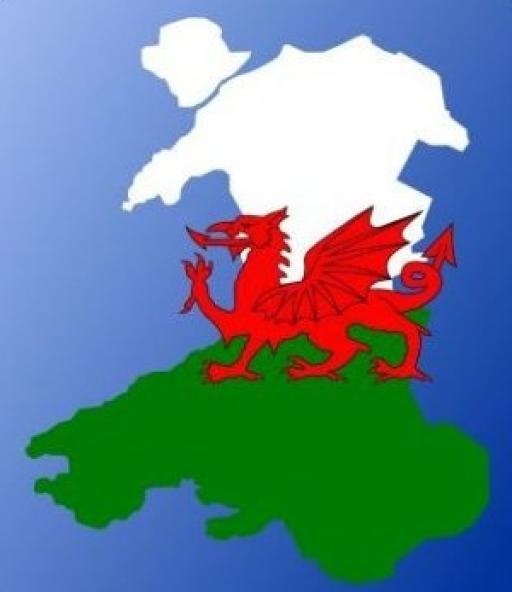
Recently Rated:
Stats
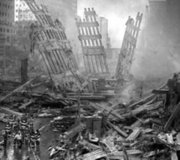 Ten years have elapsed since that fateful Tuesday morning when four hijacked aircraft rocked the foundations of the United States and changed the world. My wife and I had arrived on holiday in Wisconsin the previous evening and were having a slow start to the day. Then all hell broke loose. The phone rang at 8 am (one hour behind New York) and the friend in whose home we were staying told us to switch on the TV. Immediately, a horrific scene of the North Tower of the World Trade Center in flames appeared on the screen and less than two minutes later we watched live as the second plane smashed into the South Tower.
Ten years have elapsed since that fateful Tuesday morning when four hijacked aircraft rocked the foundations of the United States and changed the world. My wife and I had arrived on holiday in Wisconsin the previous evening and were having a slow start to the day. Then all hell broke loose. The phone rang at 8 am (one hour behind New York) and the friend in whose home we were staying told us to switch on the TV. Immediately, a horrific scene of the North Tower of the World Trade Center in flames appeared on the screen and less than two minutes later we watched live as the second plane smashed into the South Tower.
At that stage of the unfolding drama, the TV commentary was almost incoherent as trained reporters were alternating between expressions of horror, incredulity and heroic attempts to be professional. After a couple of hours we went for a walk along State Street in Madison, the main shopping street. Every shop had a portable TV showing pictures of the unfolding drama and nobody was interested in anything else. For several days all TV schedules were abandoned in favour of hastily compiled 9/11-related programming. An abiding memory was the heartbreaking handwritten or computer produced fliers posted by relatives, frantic for news of their missing family members who had worked in the Twin Towers.
So many things touched us, like the totally disproportionate appreciation expressed by so many people when the Star Spangled Banner was played at Buckingham Palace during the Changing of the Guard ceremony. Bewildered Americans, shocked that such an atrocity could happen on US soil, were hugely comforted that others overseas shared their grief. We noticed that every single house we passed was flying the Stars and Stripes or had red, white and blue rosettes on their front door as an expression of identification with a common grief.
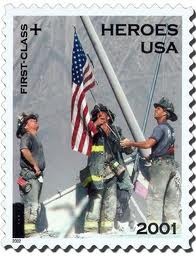 My most enduring memory is of the following Saturday when I was in Wisconsin Dells with an old friend, when we heard sirens approaching the main street. A convoy of fire engines was travelling at no more than 20 mph and the first engine had a simple laurel wreath on the front. Cars stopped and their drivers got out, people came out of shops and pedestrians quickly lined the roadside. As the vehicles passed there was spontaneous, sustained applause from everyone toward these fire-fighters who were standing proxy for their colleagues who died in New York.
My most enduring memory is of the following Saturday when I was in Wisconsin Dells with an old friend, when we heard sirens approaching the main street. A convoy of fire engines was travelling at no more than 20 mph and the first engine had a simple laurel wreath on the front. Cars stopped and their drivers got out, people came out of shops and pedestrians quickly lined the roadside. As the vehicles passed there was spontaneous, sustained applause from everyone toward these fire-fighters who were standing proxy for their colleagues who died in New York.
Sadly, we have an enduring legacy from those events of ten years ago in the security restrictions we must endure when making journeys by air. More serious is the damage done between Western and Moslem societies. The actions of a tiny number of fanatical zealots have caused permanent damage which has resulted in a climate of suspicion, hate and ignorance, fuelling membership of the English Defence League and other right-wing hate groups. The best we can do is simply to see people as people - each equally significant, important and deserving to be treated with respect, dignity and justice. That will erode and undermine the strategies of the purveyors of hate. I'm proud to be living in Wales with its long history of tolerance and inclusion of other nationalities and cultures - an example to the world.
 One hundred years ago this week an event ocurred in Llanelli, South Wales that shocked the nation. The first ever national rail strike had been called after a long period of industrial unrest particularly in Liverpool where two strikers had been shot dead by an an army officer during attacks on police vans taking convicted rioters to Walton jail. The army and local police, reinforced by a number of brutal police officers from Birmingham had fought several battles with strikers, all under the watchful eye of, and approved by, Home secretary Winston Churchill. This period of unrest culminating in August 1911 was described by the historian Eric Taplin as the nearest occasion that Britain has come to a revolution. The wave of strikes in Britain between 1910 and 1914 saw millions of workers fight over wages and conditions. This period of sustained industrial rebellion in British working class history became known as the Great Unrest.
One hundred years ago this week an event ocurred in Llanelli, South Wales that shocked the nation. The first ever national rail strike had been called after a long period of industrial unrest particularly in Liverpool where two strikers had been shot dead by an an army officer during attacks on police vans taking convicted rioters to Walton jail. The army and local police, reinforced by a number of brutal police officers from Birmingham had fought several battles with strikers, all under the watchful eye of, and approved by, Home secretary Winston Churchill. This period of unrest culminating in August 1911 was described by the historian Eric Taplin as the nearest occasion that Britain has come to a revolution. The wave of strikes in Britain between 1910 and 1914 saw millions of workers fight over wages and conditions. This period of sustained industrial rebellion in British working class history became known as the Great Unrest.
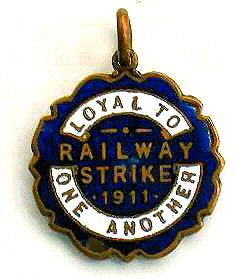 There were plenty of reasons for rail workers to strike. Prices of basic goods were rising sharply and wages were stagnant or falling. A third of railway workers were paid less than 20 shillings a week. In Llanelli, large crowds of picketers halted rail traffic. Local magistrates had requested the help of the army and soldiers were drafted in as other industrial workers came onto the streets in solidarity, joining crowds of people from the railway and dockside communities. On Saturday 19 August 1911, as strikers attempted physically to prevent a train passing through, soldiers of the Worcester Regiment opened fire, killing two men and wounding others.
There were plenty of reasons for rail workers to strike. Prices of basic goods were rising sharply and wages were stagnant or falling. A third of railway workers were paid less than 20 shillings a week. In Llanelli, large crowds of picketers halted rail traffic. Local magistrates had requested the help of the army and soldiers were drafted in as other industrial workers came onto the streets in solidarity, joining crowds of people from the railway and dockside communities. On Saturday 19 August 1911, as strikers attempted physically to prevent a train passing through, soldiers of the Worcester Regiment opened fire, killing two men and wounding others.
There were subsequent riots and, sadly as was the case last week, looting took place. The shops of the magistrates who brought in the troops were stormed and comprehensively looted. Battles took place with soldiers who tried to clear the streets at bayonet-point. Many protesters received bayonet and baton wounds, avoiding hospital for fear of arrest.
Significantly, at the height the battles the soldiers stood back and refused to engage, at one point penned in the railway station while crowds attacked it, smashing all the windows. For hours the authorities seemed paralysed, unable or unwilling to intervene as the trucks and sidings of the Great Western Railway Company were assailed, looted and burned, triggering an explosion which killed another four people. One soldier refused to fire on the crowd, was arrested, escaped from military custody and went on the run, raising the authorities fears of a wider mutiny.
 Its important to remember the people who died in these incidents. At Llanelli, ironically neither of the men who were killed were railway workers or even directly involved. Jac John was a tinplate worker, shot as he stood in the garden of No 6 High Street, overlooking the railway line. The other man Leonard Worsell was shot in his own back garden, whilst in the midst of shaving.
Its important to remember the people who died in these incidents. At Llanelli, ironically neither of the men who were killed were railway workers or even directly involved. Jac John was a tinplate worker, shot as he stood in the garden of No 6 High Street, overlooking the railway line. The other man Leonard Worsell was shot in his own back garden, whilst in the midst of shaving.
The lesson of Llanelli must stay in our minds. It is almost unthinkable that the authorities would consider ordering British troops to fire on their fellow unarmed British subjects. Last week the knee jerk reaction of many people who saw crowds of rioters outnumbering beleaguered police was Call in the army! Even in some of the Middle East countries, notably Egypt, the military refused to fire on protesters. It was heartening to hear about unprecedented assistance of police with information following our recent riots. We must oppose any move to introduce draconian measures that would undermine our successful model of policing by consensus.
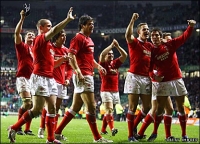 When the then Welsh Rugby Union group chief executive Roger Lewis said in an interview, Rugby reaches out in so many ways and is so much more than just a game its the glue that holds communities together., he could never have imagined how that would resonate with Welsh people. Welsh international Gareth Edwards, voted by international rugby players as the greatest player of all time, put it even more dramatically, Rugby is part of the DNA of Welshman and woman across the globe. It is at the heart of our very essence, defining us as individuals and as a nation.
When the then Welsh Rugby Union group chief executive Roger Lewis said in an interview, Rugby reaches out in so many ways and is so much more than just a game its the glue that holds communities together., he could never have imagined how that would resonate with Welsh people. Welsh international Gareth Edwards, voted by international rugby players as the greatest player of all time, put it even more dramatically, Rugby is part of the DNA of Welshman and woman across the globe. It is at the heart of our very essence, defining us as individuals and as a nation.
Stirring images of iconic Welsh singers like Bryn Terfel, Kathrine Jenkins, Aled Jones, Shirley Bassey, Tom Jones and Shn Cothi leading the crowd in Mae hen wlad fy nhadau at the Millennium Stadium might make an observer wonder why anyone would doubt that rugby was more than just a game. However, beyond the 80 minutes of passionate play and the subsequent period of bragging rights or drowning of sorrows, a case to question this assertion can be made. Looking under the skin of the role of rugby in Wales, it is quickly evident that the vast majority of Welsh people neither participate in rugby nor follow it beyond the international matches, particularly the matches between Wales and England, Ireland or New Zealand.
 The questions then arise: how, when and why did rugby assume an iconic identity for Wales. Fixing an exact date and place when anything became an iconic image of a country seems an unlikely circumstance, but a noted historian of rugby, Gareth Williams, fixes the date on which rugby assumed that role in the hearts and minds of Welshmen firmly as 16 December 1905 at Cardiff Arms Park. That was the day when Wales beat a hitherto undefeated New Zealand All Blacks team by three points to nil. Although a small margin of victory, it had to be seen in the context of New Zealand scoring 800 points and conceding only 27 against the other British teams on their UK tour that year.
The questions then arise: how, when and why did rugby assume an iconic identity for Wales. Fixing an exact date and place when anything became an iconic image of a country seems an unlikely circumstance, but a noted historian of rugby, Gareth Williams, fixes the date on which rugby assumed that role in the hearts and minds of Welshmen firmly as 16 December 1905 at Cardiff Arms Park. That was the day when Wales beat a hitherto undefeated New Zealand All Blacks team by three points to nil. Although a small margin of victory, it had to be seen in the context of New Zealand scoring 800 points and conceding only 27 against the other British teams on their UK tour that year.
It was certainly a golden age for Welsh rugby winning the triple crown six times in 12 years between 1900 and 1911 was a magnificent achievement for a tiny nation and an opportunity for pride, both for Welshmen in the old country or those dispersed throughout the world. Wales was making a major impact in rugby, to use a boxing analogy, punching well above her weight. At the time of the victory against New Zealand, Wales was at its zenith industrially with Welsh steel in the construction of much of Europes shipping, and its coal firing the boilers of those ships. Historian John Davies linked rugby closely with the industrialisation of Wales and reinforced it as a powerful symbol of the nations identity. He suggested sport, but not necessarily rugby, had become the new religion of the Welsh people rather than Christianity and Gareth Williams suggested that the ebb and flow of Welsh rugbys fortunes coincided with similar cycles in the Welsh economy and in the confidence in Wales as a nation. Whilst there is clearly a case for sport in general and rugby in particular being akin to a religion for some, a case might be made for the National Health Service taking the place of Christianity as a cherished value. Similarly, whilst the economic situation has been poor in Wales since 2008, Wales rugby has done quite well.
Comparison with Christianity is important because the Nonconformist chapels ultimately contributed a significant role in its growth. They placed a seal on the iconic role of rugby in Wales with their late-in-arriving but nevertheless positive affirmation and endorsement. Although an Anglican College, St Davids at Lampeter, had led the introduction of rugby to Wales, the Nonconformist chapels were initially vociferous in opposition, associating the game with intemperance, blasphemy and Sabbath-breaking. The religious revival of 1904 led to a marked decline in the sport in Wales and the (at least, temporary) closure of many clubs. However, the dramatic victory of 1905 made a rapid reversal of this process which led Gareth Williams to state that, [Rugby] would now play the role that religion had once enjoyed as a popular mass activity.
Eventually the ministers and deacons began to take a pragmatic view and reluctantly began to be more positive. Some even constructed sermons from the discipline that the teams showed in playing successful games. A century ago the Chapel still held significant sway in the communities of Wales and so the removal of disapproval and then affirmation of the game gave tacit permission both to be participants and to spectators of rugby.
Christianity still features, possibly only for historical reasons, in rugby. The stands still ring out with hymns like Cym Rhondda and Calon Ln amid secular songs today. Interestingly, rugby matches in south Wales where Welsh language is not widely used are still occasions when songs like Sospan Fach and Calon Ln may be heard in sometimes shaky Welsh. Cymdeithas yr Iaith Gymraeg may take some comfort!
 Max Boyce, ex-miner from the Valleys and popular comedian and folk singer wrote a number of songs that captured the intrinsic Welshness of rugby. A more reflective song, Ten Thousand Instant Christians juxtaposes the almost religious fervour and devotion of rugby fans in an ironic contrast with the closed and boarded former Chapels echoing with the hymns of yesterday.
Max Boyce, ex-miner from the Valleys and popular comedian and folk singer wrote a number of songs that captured the intrinsic Welshness of rugby. A more reflective song, Ten Thousand Instant Christians juxtaposes the almost religious fervour and devotion of rugby fans in an ironic contrast with the closed and boarded former Chapels echoing with the hymns of yesterday.
When He sees the Hope and Anchor
Where we sang before the game
Where Cwm Rhondda and Delilah
First sounded both the same
The bar was filled with singing
Hymns came on a tray
Saturday was Sunday
I wonder what Hell say
A more upbeat song of Max Boyces which inevitably features at every international Welsh rugby game is Hymns and Arias, a nod to the combination of sacred and secular singing at matches. Possibly its enduring success is because it is an account of a coach trip from south Wales to Twickenham to watch Wales play the great enemy, England. Of course, Wales won and so the somewhat worse-for-wear Welshmen were able to join in the rousing chorus:
And we were singing hymns and arias,
Land of my Fathers, Ar hyd y nos
Contained within that good-natured snipe against the English is a deeper issue. The long-standing rivalry between the nations is read by some as enmity and mention is made of any real or perceived injustice to Wales from Edward I, through exploitative pit, steelworks and quarry owners, to the Welsh Not placard that children heard speaking Welsh in some schools were forced to wear in the late 19 th century. Others will say that the enmity lasts for the duration of the match with peace being declared in the bar after the game. South Wales rock group Stereophics even brought out a song in 1999 with the title, As long as we beat the English, (we dont care).
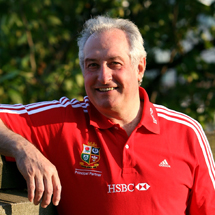 Welsh rugby gives Welsh men and women an opportunity for pride, particularly in individual players who have excelled. There can be no better example than Gareth Edwards, voted the greatest player of all time by his peers in a 2003 poll in Rugby Magazine and by former England rugby captain Will Carling as the greatest player ever.
Welsh rugby gives Welsh men and women an opportunity for pride, particularly in individual players who have excelled. There can be no better example than Gareth Edwards, voted the greatest player of all time by his peers in a 2003 poll in Rugby Magazine and by former England rugby captain Will Carling as the greatest player ever.
National Eisteddfod organiser Hywel Edwards controversially suggested that rugby shirts might be a more appropriate Welsh national costume for girls than Lady Llandoverys tall hats, shawls and aprons, or boys dressed as colliers for St Davids Day celebrations. He said, Images of children in lace aprons and colliers clothes beamed around the world on St Davids Day created an image of Wales as a backward country stuck in the past.
However, active participation in the game of rugby in Wales is not high. Compare Wales with New Zealand, a similar size nation.
| Wales | New Zealand | |
| Population | 3 million | 4 million |
| Male rugby players | 70,000 | 142,000 |
| Female rugby players | 2,000 | 6,000 |
Source: Sports Council Wales
Similarly, home attendance at Welsh regional rugby matches during 2006/07 was between 5, 000 and 10,000, whereas home attendance at Cardiff City FC was 15,000 and Swansea City 12,500. English Premiership attendance 34,000 and Manchester United FC 76,000. Sports Council Wales reported that rugby came ninth in a list of participation sports in Wales, whereas football was third.
A YouGov/Daily Telegraph poll in 2005 looked at the proportion of sports fans in Wales/Midlands taking an interest in a number of sports. Football came top at 68% and rugby was mentioned by only 48% less than half the respondents.
Despite these low proportions, Welsh people demonstrated their commitment to their national team with a quarter of the population watching rugby on TV a higher proportion than in any other country. A 2009 Wales v England international was watched by 55% of Welsh viewers but only 18% of English viewers.
What explains these inconsistencies? Welsh rugby was, and still is a classless game where its players were historically as likely to be consultant surgeons or GPs as they were to have been from the pits or the steelworks. That level playing field has contributed to Waless embracing the game to her heart.
Kenneth Morgan asserts that Rugby was, and remains, an attractive aspect of the national identity of Wales, but points out that nationalists feel preoccupation with rugby diverts people from the greater priority of national independence. That reservation by nationalists does reflect some other issues. The heartland of nationalism, north and west Wales is largely rural, other than some medium size towns on the north Wales coast. They are also areas with the greatest concentration of Welsh language and a very different focus of sport: walking, climbing, mountain biking use and sea-based pursuits. Theres no historic tradition of rugby in these areas and many football fans in north Wales look to the great football clubs of north-west England which are easily accessible. The large Magners League clubs are all based in south Wales: Cardiff, Newport, Llanelli and Swansea.
If culture, geography, language and sports interest were the sole factors that determine the role of rugby as an icon of Wales, then one could make a stronger case for rugby being more than a game predominantly in south Wales. The huge crowds on the terraces, at least of international matches, are united in their commitment to their national team, becoming a huge corporate sixteenth player.
Rugby (in reality, international rugby) brings people together with a mixture of nostalgia, pride in a nations achievement, a reflection of Welsh values and a history of great success in an environment where the Welsh language features in a non-divisive way and it can genuinely be described as more than a game.
(I wrote this a year ago as part of my Welsh History studies at Bangor University but thought rugby fans and haters alike might be surprised at the true interest in Welsh rugby. References, sources and bibliography are available on request.)
 To most Brits, Frank Lloyd Wright is just the name in the title of a song on the last and greatest album of Paul Simon and Art Garfunkel, Bridge Over Troubled Water . To me he's one the world's greatest architects and a personal hero. Incidentally, Art Garfunkel dared Paul Simon to write a song about Frank Lloyd Wright and this song was the answer to that dare. Art Garfunkel studied to be an architect because he thought his career as a musician would never be successful!
To most Brits, Frank Lloyd Wright is just the name in the title of a song on the last and greatest album of Paul Simon and Art Garfunkel, Bridge Over Troubled Water . To me he's one the world's greatest architects and a personal hero. Incidentally, Art Garfunkel dared Paul Simon to write a song about Frank Lloyd Wright and this song was the answer to that dare. Art Garfunkel studied to be an architect because he thought his career as a musician would never be successful! I've visited Wright's house in Oak Park, Chicago and seen many of his iconic buildings including the Guggenheim Museum in New York and his summer home Taliesin (left) in Wisconsin which I have visited. Wright's parents, William Cary Wright and Anna Lloyd-Jones, originally named him Frank Lincoln Wright, which he later changed after they divorced in honour of his mother's family, the Lloyd Joneses who had emigrated from Taliesin in mid-Wales. I recall visiting his grave in Wisconsin which was moved shortly afterwards to Arizona. Many people locally remembered Wright as famously eccentric and as a man who never paid any of his bills to local shops!
I've visited Wright's house in Oak Park, Chicago and seen many of his iconic buildings including the Guggenheim Museum in New York and his summer home Taliesin (left) in Wisconsin which I have visited. Wright's parents, William Cary Wright and Anna Lloyd-Jones, originally named him Frank Lincoln Wright, which he later changed after they divorced in honour of his mother's family, the Lloyd Joneses who had emigrated from Taliesin in mid-Wales. I recall visiting his grave in Wisconsin which was moved shortly afterwards to Arizona. Many people locally remembered Wright as famously eccentric and as a man who never paid any of his bills to local shops!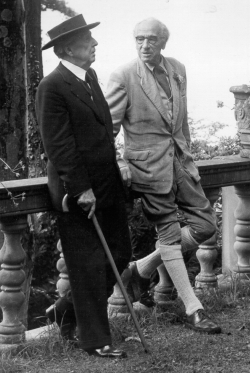 Imagine my surprise when I discovered that Frank Lloyd Wright had a connection with another eccentric architect - Sir Bertram Clough Williams-Ellis, creator of the Portmeirion village near Porthmadog in North Wales. Although born in England, Williams-Ellis' family claimed direct descent from Owain Gwynedd, Prince of North Wales. Frank Lloyd Wright visited Wales in 1956 to receive an honorary doctorate from Bangor University. He stayed with the creator of Portmeirion, Sir Clough Williams Ellis (right), whose work in Portmeirion Wright admired greatly. Both men wanted to design buildings that lived in harmony with the natural landscape. On the day of the Bangor University degree ceremony the great man, without telling Williams-Ellis, ordered a taxi to take him from Portmeirion to Taliesin in search of his Welsh roots. Clough panicked and immediately dispatched a fast motorcycle to apprehend the car, so that his guest could be awarded his degree.
Imagine my surprise when I discovered that Frank Lloyd Wright had a connection with another eccentric architect - Sir Bertram Clough Williams-Ellis, creator of the Portmeirion village near Porthmadog in North Wales. Although born in England, Williams-Ellis' family claimed direct descent from Owain Gwynedd, Prince of North Wales. Frank Lloyd Wright visited Wales in 1956 to receive an honorary doctorate from Bangor University. He stayed with the creator of Portmeirion, Sir Clough Williams Ellis (right), whose work in Portmeirion Wright admired greatly. Both men wanted to design buildings that lived in harmony with the natural landscape. On the day of the Bangor University degree ceremony the great man, without telling Williams-Ellis, ordered a taxi to take him from Portmeirion to Taliesin in search of his Welsh roots. Clough panicked and immediately dispatched a fast motorcycle to apprehend the car, so that his guest could be awarded his degree.Portmeirion is a unique place - used for many tv and film locations and is set in wonderful scenery in the Mawddach Estuary. I shall enjoy it so much more now I know of its connection with one of my heroes.
Consider the following sentences... 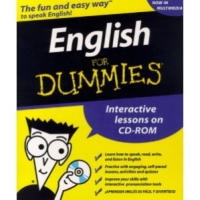
1. The bandage was wound around the wound.
2. The farm was used to produce produce.
3. The dump was so full it had to refuse more refuse.
4. We must polish the Polish furniture.
5. He could lead if he would get the lead out.
6. The soldier decided to desert his dessert in the desert.
7. Since there was no time like the present, he thought it was time to present the present.
8. A bass was painted on the head of the bass drum.
9. When shot at, the dove dove into the bushes.
10. I did not object to the object.
11. The insurance was invalid for the invalid.
12. There was a row among the oarsmen on how to row.
13. They were too close to the door to close it.
14. The buck does funny things when does are present.
15. A seamstress and a sewer fell down into a sewer line.
16. To help with planting, the farmer taught his sow to sow.
17. The wind was too strong to wind the sail.
18. After a number of injections my jaw got number.
19. Upon seeing the tear in the painting I shed a tear.
20. I had to subject the subject to a series of tests.
21. How can I intimate this to my most intimate friend?
 Now, let's compare that with the Welsh language, which, unlike English is almost completely consistent in its pronunciation rules. If you see place names local to me like Dwygyfylchi, Penmaenmawr, Penisarwaen, Llanrug, Froncysyllte, Llanfairfechan, Abergwyngregyn and Llanfairpwllgwyngyllgogerychwyrndrobwllllantysiliogogogoch - you just need to apply the rules, cover the surrounding area with waterproof sheeting and read them out.
Now, let's compare that with the Welsh language, which, unlike English is almost completely consistent in its pronunciation rules. If you see place names local to me like Dwygyfylchi, Penmaenmawr, Penisarwaen, Llanrug, Froncysyllte, Llanfairfechan, Abergwyngregyn and Llanfairpwllgwyngyllgogerychwyrndrobwllllantysiliogogogoch - you just need to apply the rules, cover the surrounding area with waterproof sheeting and read them out.
However, in almost every other aspect Welsh presents so many challenges to learners. The name of this land of Wales in its native tongue is Cymru but depending on context it might be Gymru or Nghymru. Similarly I do my local shopping in Bangor which could also be Fangor or Mangor. Counting should be easy: one, two, three, four but actually it's un, dau (or dwi), tri (or tair), pedwar (or pedair). Twenty is dau deg but sometimes ugain. Are you losing the will to live yet? Don't ask me how many ways you can say yes or no - I'm up to twenty or so but there are many more, again according to context.
So why am I a Welsh learner? Because hiraeth drew me home to Wales and although all Welsh people (round here 3 in 4 are first-language Welsh) do speak English, I want to connect with my roots and speak my grandparents' and mother's first language. Cymru am Byth!
Slate Quarry Lockouts, the Trail of Tears and News International Corporation
By Paul Dicken, 2011-07-08
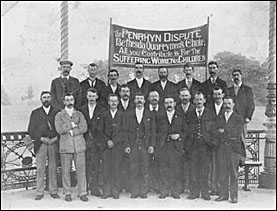 A couple of days ago I visited the Llechwedd Slate Caverns in Blaenau Ffestiniog. Llechwedd was formerly the second largest slate quarry in the world, with over 25 miles of tunnels at a depth of up to 900 feet below ground and has now been turned into a heritage attraction. On a tour the excellent young guide answered questions knowledgeably and with enthusiasm. I asked him after he mentioned the coming of the Trades Union to the quarry if it had been a difficult process like at Dinorwig and Penrhyn Quarries where there had been long lockouts by the owners with the intention of resisting unionisation a subject I am currently researching.
A couple of days ago I visited the Llechwedd Slate Caverns in Blaenau Ffestiniog. Llechwedd was formerly the second largest slate quarry in the world, with over 25 miles of tunnels at a depth of up to 900 feet below ground and has now been turned into a heritage attraction. On a tour the excellent young guide answered questions knowledgeably and with enthusiasm. I asked him after he mentioned the coming of the Trades Union to the quarry if it had been a difficult process like at Dinorwig and Penrhyn Quarries where there had been long lockouts by the owners with the intention of resisting unionisation a subject I am currently researching.
It turned out Llechwedd too had experienced intransigence and opposition resulting in a lockout for some months. The lockout at Dinorwig lasted two years and that at Penrhyn in 1903 even longer. Pause to consider; these men and boys were not being greedy, they worked in hard, dangerous, poorly paid conditions and out of meagre wages they bought their own tools, candles and blasting powder. They wanted safer conditions and a fair wage.
In the summer of 1870, the French Government drew their country into a war with Prussia but the French were surrounded and defeated. In Paris however, the citys masses had organized a National Guard and despite shortage of food, money was pooled to purchase cannons. In this move the wealthy saw a danger to themselves, no less than that posed by the Prussians. Their fear was that the masses were aroused to a revolutionary fervour and their guns could be swung toward the bourgeoisie (Government and middle classes) within the walls as easily as against the foe without.
On 18 March 1870 the Paris Commune was proclaimed. The Government withdrew with its troops to Versailles. Two months later, they attacked the Communards as they had become known, aided by Prussian officers, in May 1970 and butchered everyone. The Communards, worn and exhausted, were falling back before an advance that spared neither woman nor child. Thousands were killed where they stood; the old and sick were herded to open places to be shot and each detachment of the maddened Versailles troops was an executioner's gang, summarily killing every suspected sympathizer. The Commune was being drowned in its own blood. In that one week 40,000 workers were slaughtered and the wealthy, many of whom had now returned, stood on the curbs to watch the ghastly parade and congratulate themselves on their victory.
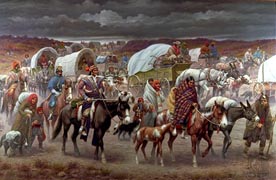 Other examples of mans greed resulting in inhumanity to fellow-man are numerous. In 1838 and 1839, as part of Andrew Jackson's Indian removal policy, the Cherokee nation was forced to give up its fertile and productive lands east of the Mississippi River and to migrate to an area in present-day Oklahoma. The Cherokee people called this journey the "Trail of Tears," because of its devastating effects. The migrants faced hunger, disease, and exhaustion on the forced march. Over 4,000 out of 15,000 of the Cherokees died. All because the white man wanted their rich productive lands.
Other examples of mans greed resulting in inhumanity to fellow-man are numerous. In 1838 and 1839, as part of Andrew Jackson's Indian removal policy, the Cherokee nation was forced to give up its fertile and productive lands east of the Mississippi River and to migrate to an area in present-day Oklahoma. The Cherokee people called this journey the "Trail of Tears," because of its devastating effects. The migrants faced hunger, disease, and exhaustion on the forced march. Over 4,000 out of 15,000 of the Cherokees died. All because the white man wanted their rich productive lands.
The events in these three countries have two common themes. They all affected communities that were poor, seeking to better themselves, were committed to each other and had no means of defending themselves. The second theme was they were all exploited and crushed by powerful wealthy people without morality whose greed was without bounds.
News International Corporation is in exactly the same mould. They are ruthless, they crush anyone who opposes them and all for the aim of making more money at any cost. Unsurprisingly, they have a non-union policy. They committed a speechlessly cynical act yesterday in closing the News of the World, sacking their 200 employees men and women with families, mortgages and now, unemployment. All to detract from their plans to take full control of BSkyB and enlarge the Murdoch empire. Well, the Bible says What you sew, you reap and for my atheist friends Chickens come home to roost!. I hope it happens sooner rather than later.
More blogs on www.hiraeth.org.uk/blog
A few weeks ago I discovered that the people of Wales had a remarkable involvement with the American Civil Rights movement. On 15 September 1963 (a fortnight after Martin Luther King's 'I have a Dream' speech) a bomb was planted in a Birmingham, Alabama Baptist church and four little girls were killed. The anger round the world was keenly felt by Welsh artist John Petts who resolved to donate a stained glass window to go into the rebuilt church. He enlisted the help of the Western Mail which appealed for subscriptions, the maximum donation being 2s 6d (20 US cents today) so no rich person could pay for it all. The people of Wales - especially the children - responded in their tens of thousands and the window was installed in the rebuilt church in 1965.
The event was dramatically captured in Joan Baez's haunting song Birmingham Sunday (see it on You Tube here) - long a favourite of mine. No other issue has shaped my philosophy, passion for justice, hatred of discrimination and my respect for all men than the Civil Rights movent. I grew up in the 60s with Pete Seeger, Bob Dylan, Joan Baez, Peter Paul and Mary, Woodie Guthrie and other protest singers and I can still cry with some of the songs and images of the times.
That morning was one of my proudest moments in many years - to learn that the people of Wales joined in solidarity and friendship with the black people in the most racially bigoted city in the United States. I was never prouder to be Welsh.
This was a sample blog that I posted a few weeks ago. If you'd like to read the blog of a Welshman living in Snowdonia on Welsh history or anything that is my passion of the moment, then click on www.hiraeth.org.uk/blog - the blog of a Welshman who heard the call of hiraeth , the link with the land of Wales, its half-forgotten past, its language, its call to the spirit. It connects with the rocks, the earth, the lakes and rivers, the trees and the waves. It's Wales.
